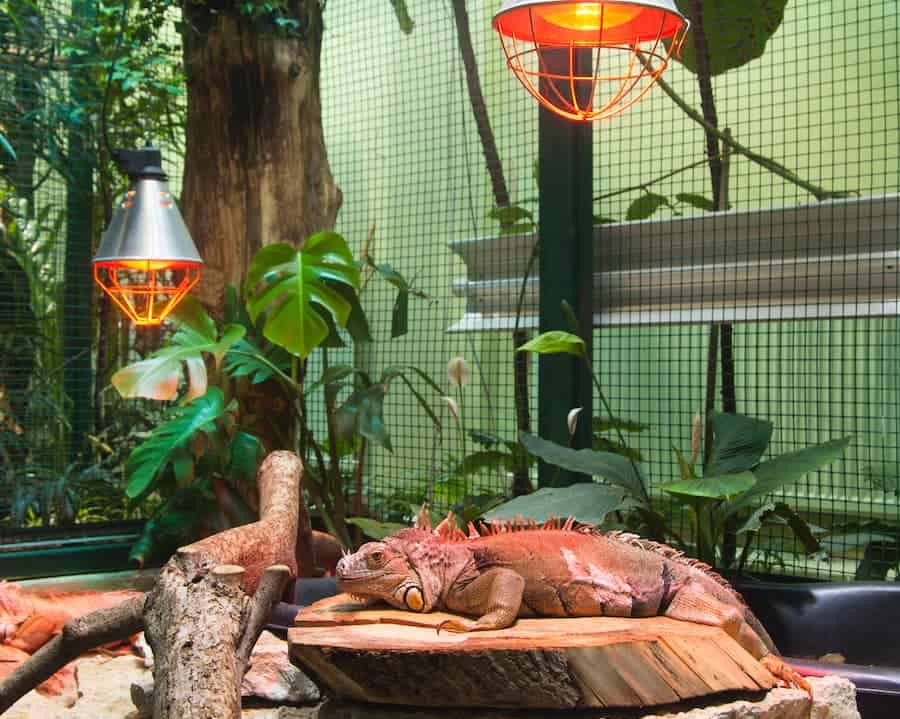Are you thinking of getting an iguana as a pet and wondering how much it will cost? Owning an iguana can be a lot of fun, but there are many costs you may not have thought about.
The total monthly cost of owning an iguana adds up to roughly $50. This includes food, lighting, and substrate. The initial upfront cost of bringing home a new iguana can easily add up to $1000, as lamps, the enclosure, branches, the iguana itself, bowls, humidifier, gauges, and a vet checkup will be required.
This guide will outline the average costs of what you’ll need to raise a happy iguana and ways to save on these costs without risking your iguana’s health.
Upfront Cost of Owning an Iguana
Iguana

Before worrying about all the upfront costs of owning an iguana, you need to buy your reptile. You may spend:
- $25 for a baby spiny tailed iguana
- $350+ for other breeds
It’s always better to spend money on a healthy iguana that will live a long time than to buy the cheapest one you find. Iguanas demand a lot of care, and emergency vet bills can be very expensive.
If you’re not sure what constitutes a healthy iguana, check out this post I wrote titled, “11 Signs of a Healthy Iguana.”
An iguana with an infection can easily cost you thousands of dollars in vet bills.
When purchasing the iguana, be sure to research the seller and examine the lizard to ensure that it is happy and healthy.
Substrate

Substrate is the material that covers the floor of your iguana’s cage or habitat. The purpose of the substrate is to absorb and contain your iguana’s defecation.
You can find exceptional reptile substrate made by ReptiChip.
If regular iguana substrate isn’t an option for you, alfalfa pellets (or rabbit pellets) are a great alternative. You can expect to spend around $20 a bag for high-quality pellets.
Food

Another obvious expense of owning an iguana is food. Iguanas are herbivores, and they do best with varied diets.
Ideally, their diets should consist of:
- Up to 45% leafy greens, such as kale, collard greens, mustard greens, spinach, bok choy, dandelion greens, etc.
- Up to 40% other veggies, such as green beans, zucchini, peas, carrots, bell peppers, alfalfa pellets, etc.
- 10-15% fruits, such as blueberries, blackberries, apples, pears, cherries, strawberries, kiwis, etc.
- Up to 4% grains, such as pasta, rice, bread, etc.
- 1-3% supplemental protein, such as commercial iguana food, tofu, etc.
Food costs can vary greatly depending on the size of your iguana, local food costs and other factors. For the average person, feeding an iguana can cost anywhere from $20-$50 per month or more.
Of course, the bigger the iguana, the higher the cost.
Vet Visits
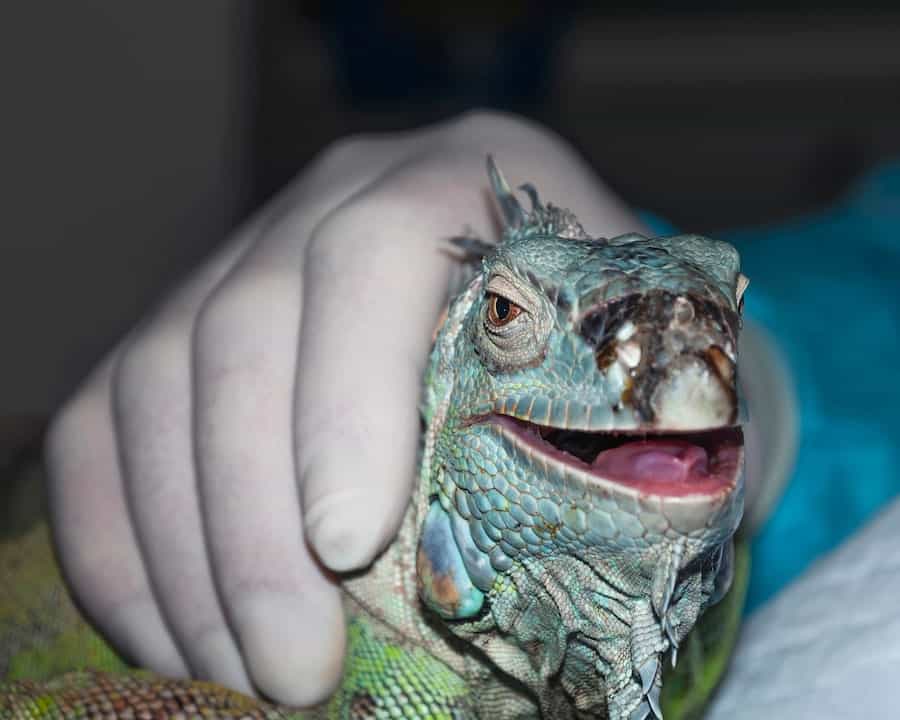
All pets, including iguanas, will need veterinary care. Your reptile will need an:
- physical exam upon purchasing the reptile
- At least one checkup per year
Some vets recommend two checkups per year so that they can detect and treat diseases early on.
Vet visits may include:
- A physical exam
- Blood test
- Fecal analysis to check for parasites
- Radiological tests to look for tumors, masses or enlarged organs
- Skin scraping to check for mites
- Microbiological test to check for yeast and abnormal bacteria
The initial vet visit may cost around $50, and yearly checkups will have a similar cost. Fecal checks cost around $15-$20 every 6 months. Things like bloodwork, skin scraping and other tests on the list above will come at an additional cost in most cases.
Some iguana owners estimate they spend $200+ on vet visits per year. Of course, costs can vary greatly depending on where you’re located.
As an iguana owner, you should also be prepared to pay for unexpected vet visits if your iguana suffers an injury or develops an infection. Depending on the situation, you may need emergency care for your reptile.
Branches

Iguanas are arboreal animals, which means they love to climb. In the wild, they spend their time high up in the trees. Your goal as an iguana owner is to create a habitat that’s as close as possible to its natural habitat.
To make their home comfortable, you’ll need to add branches or limbs. The best branches are:
- Wide enough to support your iguana comfortably
- Free of pests, poisons and resins
High-quality artificial branches are usually a safe bet. A good one, like this one from Exo Terra, will run you about $40 for one.
Humidifier
Wild iguanas live in hot and humid environments, and you’ll need to recreate this humidity in the habitat you create for them.
A humidifier can help keep your iguana’s habitat at the right humidity level. Technically, you can use any type of humidifier you want.
However, it’s important to note that too much humidity can lead to bacterial and fungal growth. A regular humidifier may not have the level of control you need to maintain a healthy humidity level.
An automatic reptile fogger is a great option because you can set timers and adjust the temperature and humidity level with greater precision. A quality humidifier like this will cost around $70.
UVB Bulb
When natural sunlight isn’t an option, a UVB bulb can help your iguana meet its sunlight requirements.
A quality bulb, like this one from Lucky Herp, is made for reptiles and will emit both UVA and UVB light. Bulbs like these can run anywhere from $17-$30.
Heat Bulb

Heat bulbs are the standard option for heating an iguana’s habitat. They make it easy to create a basking area for your reptile on a branch or limb.
A ceramic heat emitter is a great option. It doesn’t emit any light, so it won’t affect your iguana’s sleep. These “bulbs” cost about $14 for a pack of two.
Lamps
To put your UVB bulb to good use, you’ll need a lamp. Ideally, you want a lamp that you can reposition easily and is designed for use with reptile enclosures.
A good reptile lamp fixture will cost between $25 and $40 on average.
Temperature & Humidity Gauges
Iguanas thrive in hot and humid environments, but it’s a delicate balance that must always be monitored and adjusted as needed. If their environment gets too hot or too cold, your iguana’s health can quickly deteriorate.
Temperature and humidity gauges can help you maintain the right balance of heat and moisture in your iguana’s habitat. A temperature/humidity sensor made for reptile enclosures will cost anywhere from $12-$15.
You can also use a small bowl of water to add humidity to the cage. But iguanas may also decide to use this bowl as a toilet, which is not ideal.
Cage
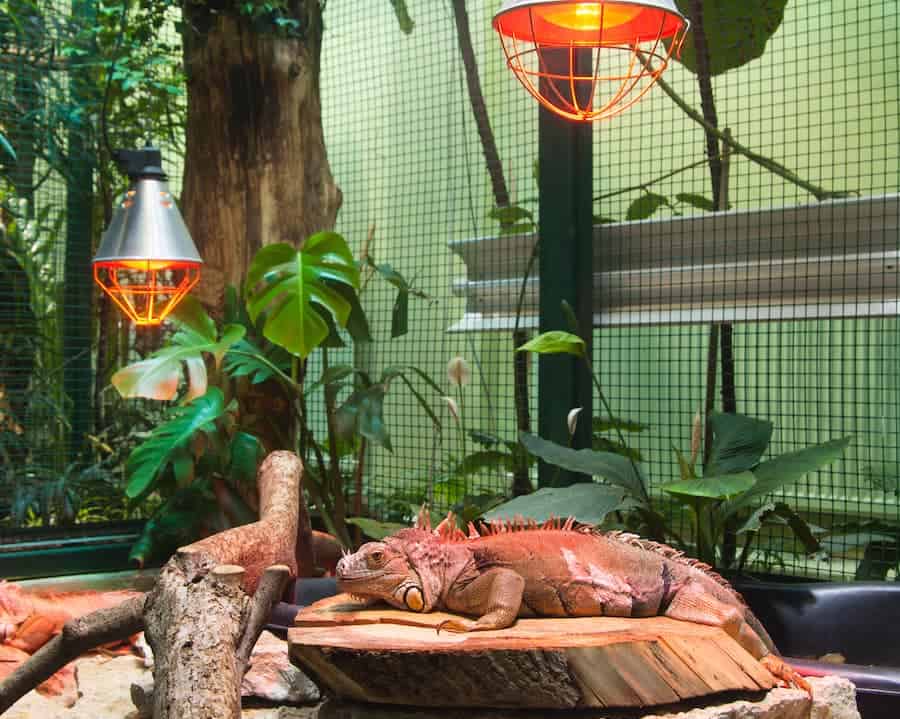
Iguanas need their own space and a cage that is an appropriate size for their age. A size-specific enclosure is ideal for iguanas, and you may need to upgrade the space a few times as they grow.
Exo Terra sells a decent starter cage for a very affordable price.
However, you’ll need to upgrade to a large cage within the first year or so as iguanas grow rapidly.
Adult iguanas can easily demand cages with:
- 8-feet length
- 8-feet height
- 3-4-feet depth
Iguanas can easily grow to 5 – 6 feet long, and the cage must be able to house them comfortably for them to remain happy and healthy.
Food & Water Bowls
Iguanas need food and water bowls. Shallow bowls are a good option for both feeding and watering. A smooth bowl bottom will make cleaning easier, and it’s never a bad idea to have more than one bowl.
A nice large bowl costs $15 – $20, but they will last years.
Monthly Cost of Owning an Iguana
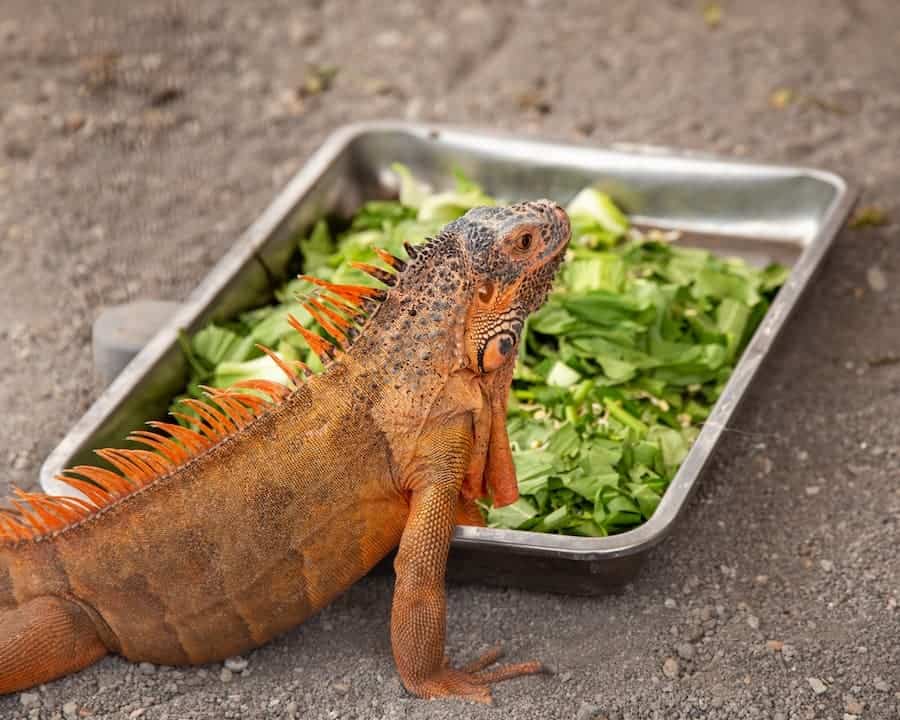
If you’re trying to budget for your iguana, you can find estimates below:
Food, Utilities, & Substrate
One interesting post on Quora tracks the owner’s iguana upkeep costs over 13 years, and he spent nearly $8,000 on his well-cared-for pet during this time.
Where did the costs come from?
- Enclosures
- $200/year in vet bills
- $200/year in food
- $120/year lighting
Substrates may also need to be purchased, but many experts recommend using newspapers or paper towels. If you have newspapers delivered anyway, it will cut back on substrate costs.
However, there are also costs for humidifiers, accessories and building materials for your pet’s enclosure. One thing that is important to note is that the Quora respondent mentioned above spent $11,000, but $3,000 was for an emergency infection.
Based on this information, you’ll pay less than $50 per month for your iguana’s upkeep, but there are variables, such as lighting, which are hard to pinpoint.
P.S. We’ve also seen vet bills be much less expensive than this amount, but it depends on your location and vet.
Now I’m going to share some great tips on how to save money regarding iguana costs.
How to Save Money on Owning an Iguana

Owning any pet is a time and financial investment. I’m going to share some of the secrets to saving money on owning an iguana that I’ve learned over the years.
Note: Never try to save money on ownership at the expense of your iguana’s happiness. Iguanas are very emotional pets and become stressed easily.
If you’re not sure whether an iguana is stressed, check out this post I wrote titled, “15 Signs an Iguana is Stressed & What to do About it.”
Use Newspapers as Substrate
In his book “Green Iguana The Ultimate Owner’s Manual,” iguana expert James Hatfield recommends using folded paper towels taped to newspaper as a substrate. The great news is that both materials are inexpensive.
Some recycling centers will let you take as much newspaper as you want for free. You likely already have paper towels in your home, but you can save on this expense by buying them in bulk.
Ask Your Local Grocery Store for The Food They Throw Out
Food can be expensive, so one thing I did was talk to an employee at my local Albertsons.
The employee mentioned they throw out kale all the time, and that he’d rather give me a box full of kale on a weekly basis instead of having it all go to waste!
The food was going to be thrown out anyway, so it was a win-win for everyone. You can try asking your local grocer for any veggies they plan on throwing out.
Buy Complete Packages (Especially Bulbs & Lamps)
Initial upfront costs are a major concern for potential owners. You may want to try:
- Buying iguana supply packages
- Purchasing bulb and lamp packages
You can often save some money by purchasing products that are packaged together for iguana or reptile owners.
Use Branches from Your Local Mountains or Woods

Buying branches is possible (we linked one previously), but you can also find branches in your local area. Go to a park, in the woods near your home, or somewhere similar to find these items.
However, bacteria will be a major concern.
You don’t want the branches to transfer any bacteria to your pet. Thankfully, you can kill the bacteria by baking the stick in the oven.
- Set your oven to a temperature of 200°F
- Allow the wood to bake for 1.5 hours on each side
Many people recommend boiling the sticks for 6+ hours, but these will need to be very small sticks and are not the best option for larger iguanas.
Build Your Own Cage

Cages are expensive, but if you’re handy, you can build your own cage to save money. You’ll want to remain cautious of lumber prices because higher prices may outweigh the benefit of making your own enclosure.
You can find plenty of tutorials online for building a cage and videos, too.
Pro tips:
- Visit city salvage yards to save on lumber
- Ask glass companies for odd-sized glass you may need
Use Your Own Bowls
Purchasing iguana bowls is nice because they have wooden-looking bowls that may make your lizard feel more “at home,” but you can also use your own:
- Bowls
- Plates
- Jar lids
- Etc.
Is Owning an Iguana Time Costly?
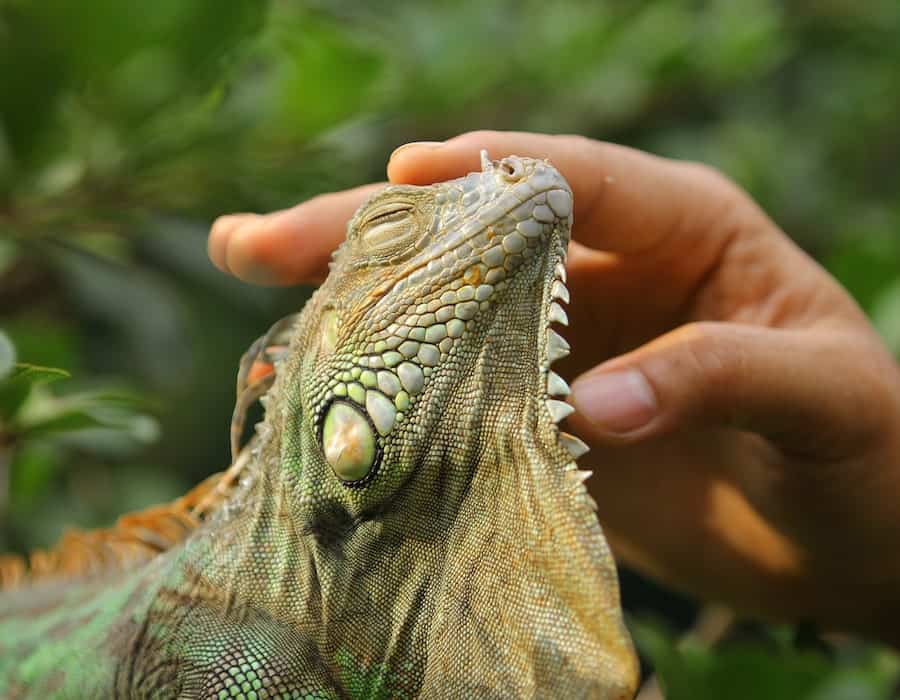
Yes and no.
Iguanas can be difficult to care for and will require a time investment to keep them happy and ensure that they’re in the right environment.
If you build your own enclosure, you can add to this time cost even more.
Taming can be extremely difficult. Iguanas are filled with personality, and while some are quick to train, others can take years to train.
If you don’t have patience, you may want to consider a different reptile.
Are Iguanas Good Pets for Beginners?

Iguanas are not good pets for beginners.
Owning an iguana is a major responsibility. Iguanas are not the best pets for beginners, and you can find out why in my post, “Are Iguanas Good Pets for Beginners?”

